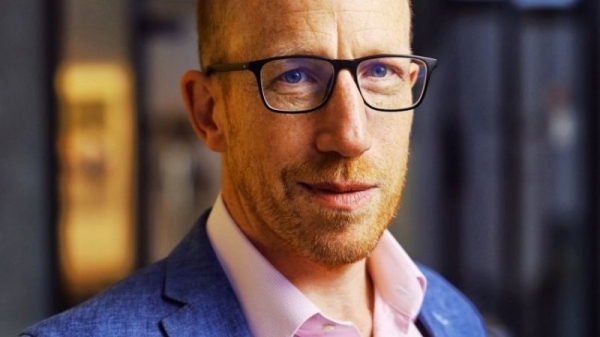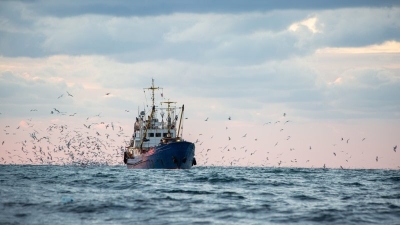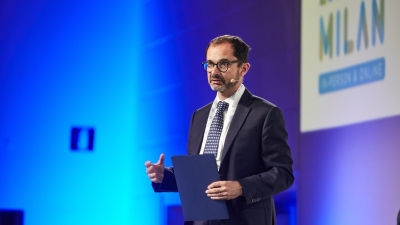EIT Food’s Regenerative Innovation Portfolio forging new business models for farmers, says CEO

EIT Food recently announced the creation of the Regenerative Innovation Portfolio to improve regenerative agricultural practices in Europe and drive innovation throughout the agri-food value chain. Euractiv’s Christoph Schwaiger spoke with EIT Food CEO Richard Zaltzman, to discover how the funds will be used.
EIT Food, which is part of the European Institute of Innovation and Technology (EIT) innovation network, sees regenerative agriculture entailing farming practices which increase biodiversity, enrich soils, and ultimately result in more financially sustainable rural communities.
The Regenerative Innovation Portfolio is designed to help European farmers decrease their financial risks, fine-tune their operations, and test scalable future-proof solutions
CS: How does the Regenerative Innovation Portfolio work in a nutshell?
RZ: It’s an initiative that brings together stakeholders across the food system value chain to work on a landscape-level transition through regenerative farming and therefore create a regenerative landscape from which we can source crops.
It happens at a landscape level, a significant geographical area of reasonably homogeneous agricultural practice. It involves the whole food value chain, starting with farmers all the way through retailers and finance, bringing in all the food companies in that value chain in order to co-invest in the transition of that landscape for mutual benefit.
CS: Has EIT Food done it before, or is it your first attempt creating something like this?
RZ: We’ve got many of the components already and now we’ve plugged them together in the portfolio for the first time.
A regenerative transition for farming starts from the farmers. So we’ve been doing farmer training and farmer engagement for many years. We’ve got some amazing pioneer farmers who’ve taken the risk to change what they do. We know how to bring farmers together and how to create farmer learning networks.
There’s lots of innovation in the regenerative space and we’ve got start-ups creating interesting technology.
It’s been nearly two years in the making and we consulted with different stakeholders to construct the portfolio in a way that delivers on its core objectives, which are about creating a viable financial transition for farmers.
We’ve learnt that farmers respect other farmers. If you want to trigger a change in the farming community, the singular most effective way of doing that is for farmers to talk to other farmers. So we’re trying to build that network of pioneer farmers who ultimately end up with the landscape that they’re proud of, being more profitable, and have their neighbours look over their farm gate and think: How do I get involved in that?
CS: You’re aiming for a portfolio of €30 million where you’ll be matching the investments being made. How will that work in practice?
RZ: The key is that there’s innovation involved. We don’t know today how to tackle all of these challenges. So, when we look at some of the things we’re trying to achieve; models, viable markets for ecosystem services – for example, we know it’s possible already, but we don’t know how to create multidimensional marketplaces for ecosystem services.
For example, biodiversity or nitrogen use efficiency. I want to emphasise this is an innovation portfolio. It’s not a project with a highly determined degree of outcome certainty.
What do we do? We identify a landscape first which could be hundreds of square kilometres or smaller. And we’re looking at 300 to 500 farmers, so quite a significant landscape.
And we want to address the landscape because we need to engage the value chain within that landscape from the farm gate all the way through to the retailer. We start with the farmer engagement, so supporting them to develop their capability for regenerative practice and that varies by landscape. Then we’ll work on the innovation and getting a practice to be scalable and become permanent.
Looking at finance mechanisms that can support farmers, the current ones are pretty standard. Farmers take out a bank loan, invest in equipment, and pay the loan back plus interest. We’re going to invest in innovation to find different financing mechanisms. I’m asked all the time: What are you actually going to deliver? We don’t know. That’s the whole point. Because it’s an innovation challenge.
But imagine you could create a whole value chain bond where in a landscape all the parties in that chain invest capital for a 10-year commitment to the total agricultural output of a farm. That spreads out the risk across the whole value chain instead of being borne by a single farmer. We want to explore things like that and push the innovation envelope of what is possible to de-risk the transition for that farmer.
We’re working on multiple landscapes. We’ve got the first one in Spain up and running. We’ve got five others that we’re working on, including in Poland, France, the UK, and Ireland.
CS: So, will this initiative mainly be beneficial for the large agro-industrial farmers or is it also beneficial for the everyday farmer?
RZ: It’s very much beneficial to the everyday farmer. We’re seeing that’s very much where some of the majority of our pioneer farmers are. It’s the independent small and medium farmers who are really strongly engaged in this. That’s not to say the large-scale agricultural farms are not involved. But they’ve already got different relationships with companies.
The science says that our current agricultural model is not resilient and we’re starting to see that in an increased rate of crop failure for multiple reasons. If we do not transition our agricultural model to a strongly resilient model, which we believe is founded on regenerative practice, Europe’s food system is in dire jeopardy.
Some of this is about really rethinking the business model and probably re-localising some of it. Imagine a ‘Landscape A’ with mostly wheat. As it transitions to regenerative practice, you’re going to have less wheat, but maybe three other crops and a whole range of ecosystem services coming off that landscape.
‘Landscape B’ goes through a similar transition, and maybe the wheat that Landscape A is no longer producing is now produced by Landscape B. As a wheat sourcer, you might now re-localise your supply chain and buy it from landscapes A and B, instead of just A. This third pillar of the portfolio is about reengineering the supply chain.
CS: If this is ultimately about crops being produced and sold, who will be the ultimate beneficiary of the €30 million? Because if it’s going to the end of the chain it starts to sound a bit like trickle-down economics.
RZ: The money does not go to the companies. It comes from the companies. Around 40-50% of that money is going straight to farmers to support farmer training and long-term agronomic advice. It’s very much focused on the farmer transition. The rest will fund ideas that solve specific challenges in a landscape that come from the innovation community. Things like biologicals and mechanical weeding.
We will also do the same innovation challenge for the finance sector, which talks a lot about innovation but very little ends up happening. And finally, reengineering the supply-demand. Perhaps farmers can start to plan collectively what crops they’ll be growing and when.
CS: How are we going to ensure the changes made outlast the Regenerative Innovation Portfolio?
RZ: We need to prove that this is a viable business model and is a pathway for transformation at scale. The initial feedback shows this is something farmers will really stick with because fundamentally, it’s a lot more profitable. Currently, there aren’t many ways a farmer can increase their margin.
Regenerative farming gives you a real platform to get higher value for your crops, develop adjacent revenue streams, cut your input cost, and be more profitable.
CS: The Commission recently introduced a partial exemption, so farmers don’t have to leave their land fallow. EIT Food is promoting regenerative agriculture. Are you heading in opposite directions?
RZ: Good question. While the policy might be weakening, that doesn’t mean there’s not going to be momentum for this. We believe that companies want this and consumers want to know that their food is coming from a sustainable platform. The political environment in Europe is very turbulent at the moment meaning compromises have to be made. Some of those compromises are a bit disappointing.
Regardless of the peeled-back laws, we’ve demonstrated to farmers that going above and beyond what the law states makes them money.
CS: Since you’re EIT Food’s former Chief Impact Officer, I of course must ask, how are you going to be measuring the success of the portfolio?
RZ: We’ll have to prove there are viable transition models at scale that are financially viable to farmers and deliver a range of ecosystem services that allow us to remodel the supply-demand nature of the environment.
If we get this right, in 10 years those landscapes that we start now will be more resilient. There will be a lower rate of crop failure. Farmers will be more profitable.
There are many metrics we can measure such as the production of crops, net revenues, and the number of hectares under regenerative practice.
Ultimately you want to walk around those fields in Poland, France, and so on and see a very different landscape that looks much more diverse, with stronger wildlife, and better water management. It’s about those communities showing signs of being sustainable, regenerative, and frankly, wealthier.
[By Christoph Schwaiger I Edited by Brian Maguire | Euractiv’s Advocacy Lab ]
Read more with Euractiv




